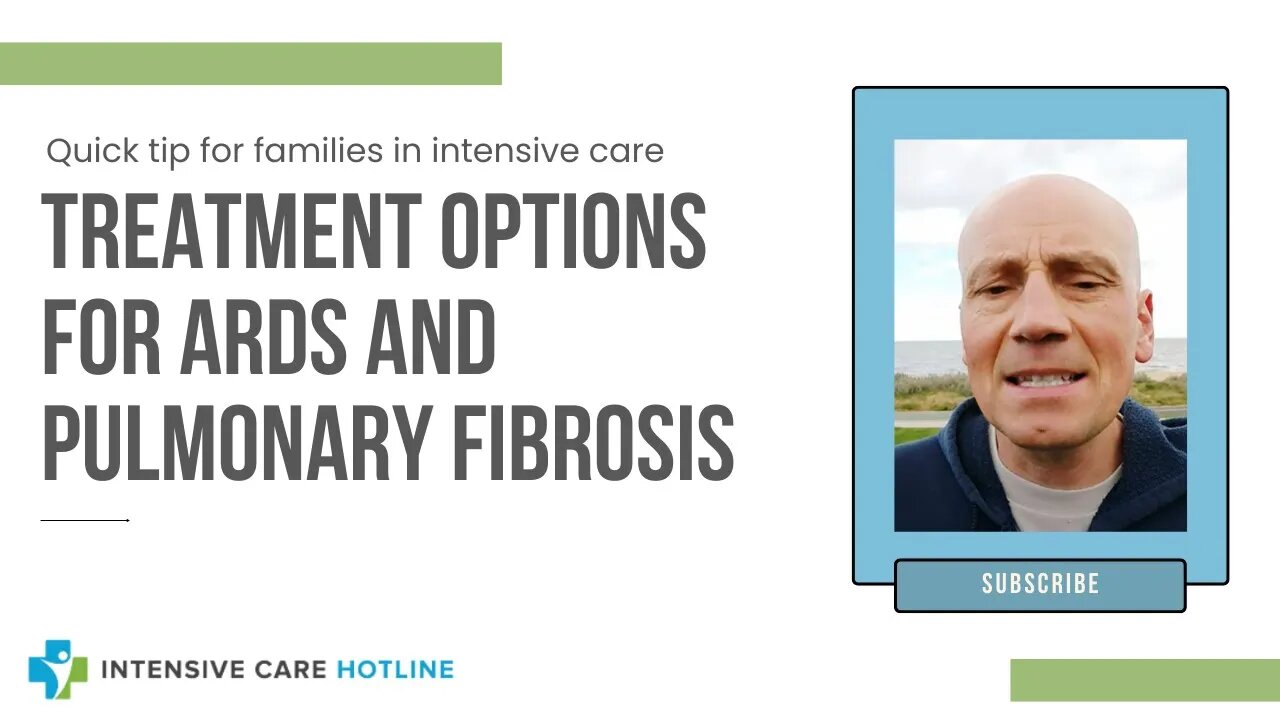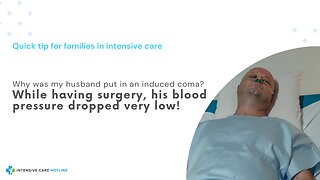Premium Only Content

Quick tip for families in Intensive care: Treatment options for ARDS and pulmonary fibrosis
Quick tip for families in Intensive care: Treatment options for ARDS and pulmonary fibrosis
Book your free 15 minute phone consultation here
http://intensivecarehotline.com/scheduling-appointment/
Call directly 24/7
+1 415-915-0090 USA/Canada
+44 118 324 3018 UK
+6141 094 2230 Australia
Email support@intensivecarehotline.com
Get 1:1 consulting and advocacy
1:1 phone counselling
http://intensivecarehotline.com/one-on-one-counselling/
Become a member for families of critically ill Patients in Intensive Care
https://intensivecarehotline.com/intensivecaresupport-org-membership/
Immediate action steps http://intensivecarehotline.com/take-control-take-charge/immediate-action-steps/
https://intensivecareathome.com
And if you need a medical record review , click on the link and we can help you with reviewing your loved one’s medical records while they’re in ICU.
https://intensivecarehotline.thrivecart.com/review-of-medical-records/
Hi, it’s Patrik Hutzel here from intensivecarehotline.com with another quick tip for families in intensive care.
Today’s tip is about, “ARDS (Acute Respiratory Distress Syndrome), pulmonary fibrosis, and treatment options in intensive care.” So, we are currently working with a client that has their 59-year-old mother in intensive care with ARDS. The ARDS was not COVID-induced. She ended up in an induced coma on multiple inotropes, on paralyzing agents, in prone position for a couple of weeks, and finally was being able to be weaned off the ventilator down to 40% of oxygen. She had some CPAP (Continuous Positive Airway Pressure) trials, which lasted for a few hours, but never anything to push it further.
Now, part of the ARDS led to pulmonary fibrosis, also known as scar tissue in the lungs. So, what happened from there is that the lady had issues in being weaned off the ventilator. Her carbon dioxide was rising. Pressure support had to be increased. Her respiratory rate had to be increased as well, and she ended up on up to 90% of oxygen and with her chest infection as well.
Now, from my experience, after having worked over 20 years in ICU in three different countries, where I also worked as a nurse unit manager for over five years, for example, nitric oxide might be another treatment option. Epoprostenol or Flolan nebulizer might be an option for pulmonary fibrosis or sildenafil or Viagra because most of those patients have pulmonary hypertension. And that could lead then, especially for a 59-year-old lady, to a lung transplant.
Most families in intensive care have no idea what to look for, what to ask for. Their biggest challenge is that they simply don’t know what they don’t know. And the intensive care team would’ve not given them any choice, any options, and would’ve brushed any of those treatment options aside unless we had asked on the family’s behalf to look into those options. Now, whilst the intensive care team has not commenced any such treatment options, at least it puts the power back to the family and lets the intensive care team know that there’s someone professionally advocating for their loved one. Most families in intensive care have no advocate whatsoever. And again, they don’t know what they don’t know. They don’t know what to look for. They don’t know what questions to ask. They don’t know their rights and they don’t know how to manage doctors and nurses in intensive care.
So, you really have to do your research from day one in order to get the best care and best outcomes. Intensive care teams don’t want to keep patients in ICU for too long. As a matter of fact, their worst-case scenario is to look after someone with an uncertain outcome, indefinitely. And that’s exactly the situation that this family is finding themselves in their mother presents the worst-case scenario from an intensive care team. For them, it’s all about managing beds, managing staff, managing finances. And unless you are tuned in to what an intensive care unit wants to achieve, you’re fighting an uphill battle. You need to come from a different angle and that’s where we can help you with very fast.
So, that’s my quick tip for today.
If you have a loved one in intensive care and you need help, go to intensivecarehotline.com. Call us on one of the numbers on the top of our website or send us an email to support@intensivecarehotline.com.
Also, have a look at our membership for families in intensive care at intensivecaresupport.org.
If you need a medical record review for your loved one in intensive care or after intensive care, contact us as well and we can help you with that.
Continue reading at: https://intensivecarehotline.com/blog/quick-tip-for-families-in-intensive-care-treatment-options-for-acute-respiratory-distress-syndrome-ards-and-pulmonary-fibrosis/
-
 7:30
7:30
Intensive Care Hotline
3 days agoWhy was My Husband Put in an Induced Coma? While having Surgery,His Blood Pressure Dropped Very Low!
141 -
 DVR
DVR
TheAlecLaceShow
2 hours agoDan Bongino Joins Kash Patel at FBI | Vivek For Ohio | Where’s the Epstein List | The Alec Lace Show
2.43K1 -
 55:46
55:46
The Dan Bongino Show
4 hours agoChange Is Coming, And All The Right People Are Panicking (Ep. 2430) - 02/25/2025
785K1.78K -
 1:11:08
1:11:08
The Rubin Report
3 hours agoTimothée Chalamet Stuns Crowd with Speech Pushing This Conservative Value
69.8K31 -
 1:40:31
1:40:31
Benny Johnson
3 hours ago🚨Deep State DESTROYING Evidence!? FBI Caught DELETING Files, Epstein List COVERUP | Investigate NOW
86.9K98 -
 2:00:34
2:00:34
Steven Crowder
5 hours ago🔴 False Reality: What Joy Reid's Firing Exposes About The Left
398K297 -
 1:34:39
1:34:39
Tucker Carlson
1 day agoLuke Gromen: Why the CIA Doesn’t Want You Owning Gold, & Is Fort Knox Lying About Our Gold Reserve?
148K195 -
 1:03:56
1:03:56
Timcast
4 hours agoRachel Maddow SLAMS MSNBC As RACIST For Firing Joy Reid, Liberal Media HAS COLLAPSED | Timcast LIVE
95.2K62 -
 DVR
DVR
Bannons War Room
7 days agoWarRoom Live
1.8M341 -
 56:45
56:45
VSiNLive
3 hours ago $2.07 earnedA Numbers Game with Gill Alexander | Hour 1
50.5K2